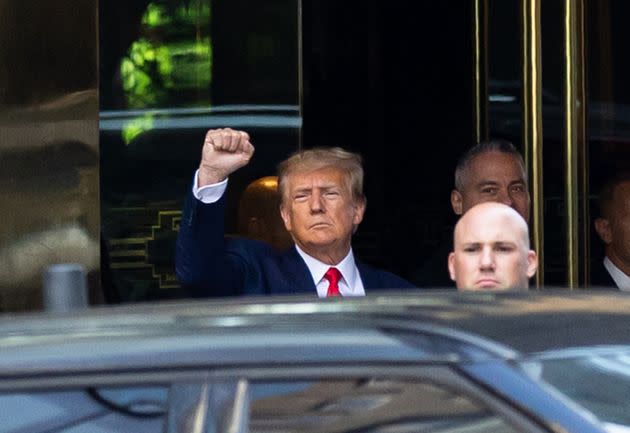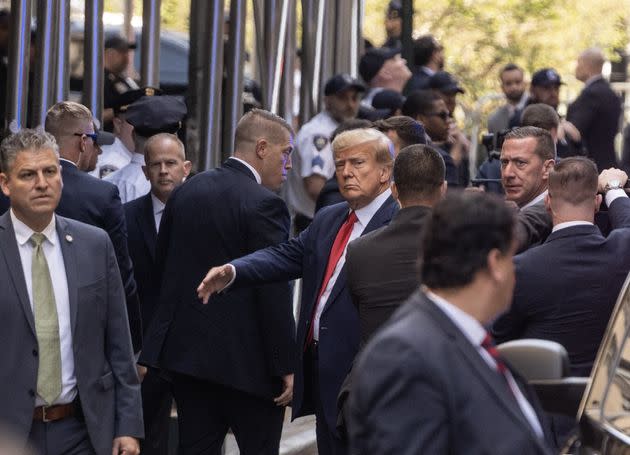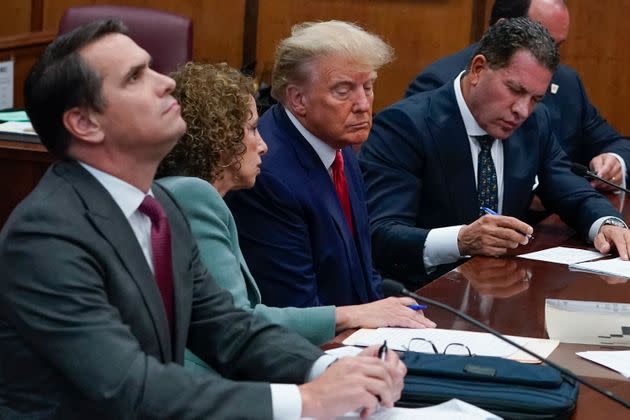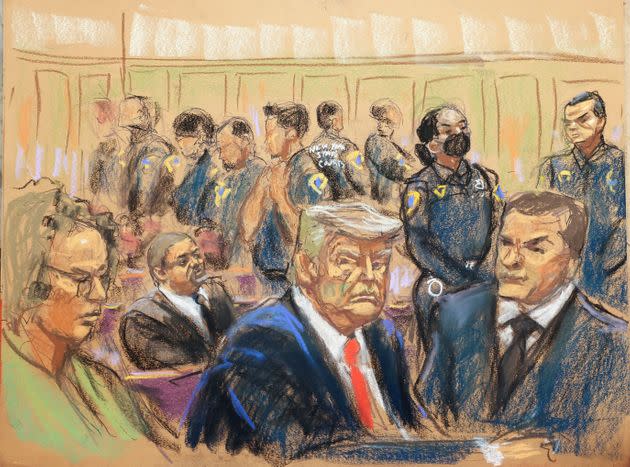Former President Donald Trump knew his body language would matter at his April 4 arraignment.
We know this because, a day before Trump appeared in a courtroom in New York City, New York Times reporter and Trump biographer Maggie Haberman was interviewed on the paper’s “The Daily” podcast and said that Trump and his team of advisers had discussed how he should present himself.
“[Trump] has spoken a lot to advisers about his so-called ‘perp walk’, where he is led down a corridor to a courtroom: should he smile or not? How should he handle it?” Haberman said.
Podcast host Michael Barbaro reflected on what might be going through the former president’s mind:[Should I look] sad? Am I smiling? Am I defiant or am I sad?”
Haberman, a journalist who has followed Trump so closely that he once called her “his psychiatrist,” said he was likely to experience a mix of emotions during the hearing.
“He can lean into the spectacle of what that day is going to be, And he may be deeply concerned about what is going to happen to him in this moment that he has been trying to avoid for decades… This is a man for whom the fear of public humiliation has been an animating force for decades,” she said.
So, how did he come across? It depends who you ask. Some commentators and reporters looked at Trump’s face and saw a man who looked “gloomy,” “sad,” and “little.” Those more firmly entrenched in the Trump camp said he looked “defiant” and “even more presidential” than ever.
To get a more professional take, we asked body language experts what they thought of Trump’s attitude throughout the day.
We especially wanted to know what he projected in court, where he was charged with 34 counts of falsifying business records in connection with an alleged scheme to cover up two cases with hush money ahead of the 2016 election.
While news outlets were denied access to the hearing, photographers from The Associated Press and Reuters were allowed into the courtroom. Other media outlets captured video footage of Trump.
The former president’s face changed over the course of the day, the body language experts told us: emboldened by his anger one moment, seemingly registering the personal and political loss the next.
As he left Trump Tower for the Manhattan courthouse, we got standard Trump bravado: first a pump and a wave to the crowd, with a stern look on his face.
The raised fist gained prominence during the Civil Rights Movement as a sign of solidarity and strength, but Trump has used the gesture many times during his political tenure.
“In this setting for Trump, he raises his fist as he addresses the crowd before going to court,” says Karen Donaldson, an author and body language expert. “I read this as a mix of achievement, solidarity with an undertone of defiance.”

As he left Trump Towers to go to court, there was an “undertone of defiance” in former President Donald Trump’s raised fist.
Arriving at the New York Criminal Court, we saw his signature scowl.
“This is his standard look that we’ve seen [for] years away from him,” says Traci Brown, a body language expert and author of “How to Detect Lies, Fraud and Identity Theft.”

Trump will appear for a grand jury indictment in New York Criminal Court on April 4, 2023.
When guys frown like that, viewers sense they’re mad at something outside of them. When women look that angry, viewers notice that they are just an angry person,” she noted.
Donaldson called the look a “confident stare-down.”
“He has security around him, but he doesn’t seem the least bit concerned when he turns around and makes time to wave,” she said.
Trump’s emotional tense seemed to change as he entered court, a scene captured on video:
Blanca Cobb, a body language expert and speaker, suggested that this could be when the trial for Trump got real.
“If you look at the clip, you see that no one is holding the door open for Trump,” she said. “Regardless of political affiliation, most people agree that a president of the United States should be treated with respect. What a fall from grace for any president.”
Brown also noticed a certain sadness.
“I’ve never seen anything like him,” she said. It soon shows in his eyebrows rising above his nose. It is a sad look that indicates a loss.”
“We don’t know what that is, but the list of possibilities [includes] reputation, money, status and power,” said Brown. “It doesn’t last long though and he returns to his angry frown.”
In court, Trump’s body language also wasn’t as forceful as it was when he left Trump Tower, Donaldson said.

At the table with his defense team, Trump looked less powerful than earlier in the day, the pundits said.
“We see him sitting with his shoulders down,” she said. “When you shrug your shoulders, you make yourself smaller; it can express fear and it is more of a protective gesture than one that conveys confidence.”

Sagging shoulders often indicate fear and the need to protect oneself, one expert said.
In the image below it looks like “his strength and confidence [have] have been taken away,” Donaldson said.
Cobb saw the deep frown on Trump’s face.
“The corners of his lips are pulled down in such a way that his chin is accentuated, indicating sadness,” she said.

In this photo of Trump, it looks like “his power and confidence have been taken away,” Donaldson said.
There was one photo that all of our body language analysts found particularly striking.
In the photo, Trump is frowning with his eyebrows and forehead raised — a facial expression that calls for next-level facial contortion.
“This is hard to do,” Brown said. “It shows a request for approval. I would like to have more context around what exactly was said at the time, but of course we don’t have that.”

Cobb read high voltage in this photo.
After years of analyzing Trump’s face for various media outlets, Brown said she had never seen anything like it in his political career.
“He’s definitely experiencing some different emotions than what he’s ever shown in public in some of these photos,” she said. “It’s unbranded.”
Cobb read high voltage on the photo.
“He’s clearly angry, as evidenced by the tightening of his eyelids and stretching and tightening of his lips,” she said. “The contracted forehead shows tension.”
Why do we care about this?
We also asked our body language experts why political pundits and laymen alike enjoy dissecting photos like this.
For starters, without video cameras in court, we’re hungry for footage. Thank goodness that’s a press pool of photos used to be allowed, because the courtroom sketches… weren’t exactly edifying:

A courtroom sketch from Tuesday’s hearing.
In general, people are always fascinated by trying to figure out what public figures are communicating with their body language, facial expressions, and clothing. (Look at all the coverage of Gwyneth Paltrow’s flashy and “billionaire-chic” wardrobe in her ski trunk in Park City, Utah, last week.)
“We want to know what is going on with someone and what is going on not is said of people we look at all the time, of every kind of celebrity,” Brown said.
Nor is it surprising to Brown that people are biased in their reading of Trump’s face in court: what is morose or quietly angry to one person is stoic and composed to another, depending on who they voted for.
“Politicians who do their best to hide emotions let them leak out, but we see what we want to see,” she said. “Body language tells you what is on someone’s mind, but not why. If people are not trained, they put their personal spin on it.”

